
copyright © Wartime Heritage Association 2012-2024
Website hosting courtesy of Register.com - a web.com company
Wartime Heritage
ASSOCIATION
Remembering World War II
Name:
Lawrence Holmes Flynn
Rank:
Sergeant
Service Number:
275404
Service:
Company C, 1st Marine Raider Battalion
(Edson’s Raiders), United States Marine Corps
Awards:
Silver Star with Oak Leaf Cluster
Date of Birth:
March 22, 1921
Place of Birth:
Brockton, Plymouth County, Massachusetts
Date of Enlistment:
October 4, 1939
Place of Enlistment:
Likely Massachusetts
Address at Enlistment:
Brockton, Plymouth Co., Mass.
Age at Enlistment:
18
Marital Status:
Single
Next of Kin:
Mrs. Mary M. Flynn (Mother),
52 Augustine Street, Brockton, Massachusetts
Date of Death:
July 9, 1943
Age:
22
Cemetery:
Arlington National Cemetery, Virginia
Grave:
Section 34, Site 1952
Lawrence ‘Larry’ Holmes Flynn was the son of Edmund Power Flynn (1879-1948) and Mary Margaret (O'Connell)
Flynn (1892-1955). His father was born in Arichat, Richmond County, Nova Scotia. His mother was born in
Orange, Franklin County, Massachusetts.
He had seven siblings - Mary C Flynn Fitzgerald (1914–2005), Edmund Paul Flynn (1916–2005), Frances
Elizabeth Flynn Connolly (1917–1999), Raymond Charles Flynn (1919–1994), Virginia Margaret Flynn Megley
(1923–2010), Robert William Flynn (1925–1972), John W “Jack” Flynn (1926-2008), and Richard Flynn (1930-
2010). Robert William Flynn served as a Corporal in the United States Marine Corps in WWII.
He also had three half siblings from his father’s first wife Ida Mae Gannon Flynn (1882–1910) - Dorothy Helen
Flynn Nilan (1903–1979), Albert Joseph Flynn (1907–1967) and Austin Lewis Flynn (1909–1956).
His brother Albert Joseph Flynn served as a Major in the US Army and Reserves in the Second World War and
the Korean War. His brother Edmond Paul Flynn served as a Colonel in the US Army, and his wife Dolores
Elizabeth served a Pharmacist’s Mate in the US Navy.
“As a boy, Larry loved poetry, reading, writing, and
especially birds. He had a special gift and a real knack
for their care. While still in High School, he operated a
hospital for birds called "Augustine Aviaries and Bird
Hospital". The Brockton Enterprise paper recognized
him as one of the youngest bird doctors in the country.
He sold bird supplies, boarded birds, and cared for and
nursed sick birds back to health. He wrote a weekly
column in the Brockton Enterprise called "Canary Care".
He kept meticulous records on all his accounts and
often received letters of
thanks for his solid
advice in his newspaper
column and for
understanding the genuine importance a pet bird could have on a person’s life.
A career as a veterinarian was on the horizon, the family thought.”
Upon enlistment in 1939, Lawrence joined the United States Marine Corps. He
mustered with Company C, 2nd Battalion, USMCR at the Navy Yard in Boston,
Mass. He was stationed at Quantico in Virginia and also at Guantanamo in Cuba
(mustered there January 1941 with Company "D", Second Battalion, USMCR,
Naval Station Guantanamo) prior to serving in the Pacific Theatre with the 1st
Marine Raider Battalion.
The US Marine Corps muster rolls detail his postings:
Dec 1939 – Private, Company C, 2nd Battalion (Bn), USMCR, Navy Yard, Boston, Mass.
Mar 1940 – Private, Co. D, 2nd Battalion, US Marine Corps Reserve, Navy Yard, Boston, Mass.
June 1940 – Private, Co. D, 2nd Battalion, US Marine Corps Reserve, Navy Yard, Boston, Mass.
.
Sep 1940 – Private, Co. D, 2nd Battalion, US Marine Corps Reserve, Navy Yard, Boston, Mass.
Nov 1940 – Private, Co. B, 2nd Battalion, USMC Reserve
Nov 1940 – Private, Co. C, 2nd Battalion, USMC Reserve, Marine Barracks, Quantico, Virginia
Dec 1940 – Private (Pte.), Co. C, 2nd Bn, USMC Reserve, Quantico, Virginia
Jan 1941 – Pte, HQ & Service Co, 5th Marines, FM Bn, Fleet Marine Force (FMF), on board USS McCawley
Jan 1941 – Pte., Co. D, 2nd Battalion, USMCR, Naval Station, Guantanamo Bay, Cuba
Apr 1941 – Pte., Co. C, 1st Bn, 5th Marines, 1st Mar. Div, FMF, Marine Barracks, Quantico, Virginia
July 1941 – PFC, Co. C, 1St Bn., 5th Marines, 1Md., FMF, aboard USS Manley, Miami, Florida
Oct 1941 – PFC, Co. C, 1St Bn., 5th Marines, 1Stmardiv., FMF, Marine Barracks, Quantico, Virginia
Jan 1942 – PFC, Co. C, First Separate M. Bn, FMF, Amphibious Force Atlantic Fleet, M. Barracks, Quantico, VA
Apr 1942 – Corporal, First Marine Raider Battalion, in Camp at Tutuila, Samoa
July 1942 – Corporal, First Marine Raider Battalion, in the Field
Oct 1942 – Sergeant, First Marine Raider Battalion, in the Field
The Marine Raiders were special operations forces originally established by the United States Marine Corps
during WWII to conduct amphibious light infantry warfare. "Edson's" Raiders (1st Marine Raider Battalion) and
"Carlson's" Raiders (2nd Marine Raider Battalion) are said to have been the first United States special
operations forces to form and see combat in WWII. The 1st Raiders were known as Edson’s for their
commander, Major General Merritt Austin Edson, Sr. (1897-1955). When WWII started Edson was sent as the
commanding officer of the Marine Raiders and earned his 2nd Navy Cross on Tulagi. When his unit was sent to
fight on Guadalcanal, Edson led his men in fighting for which he would later receive the Medal of Honor.
Sergeant Flynn was killed in action at Enogai on the island of
New Georgia in the Solomon Islands in the Southwest Pacific, on
July 9, 1943.
His actions at the Battle of Bloody Ridge on Guadalcanal in 1942
earned him his first Silver Star, and his second was awarded
posthumously for his actions at Enogai, New Georgia.
His first Silver Star:
"Lawrence H. Flynn, sergeant, United States Marine Corps
Reserve, for conspicuous gallantry and intrepidity during
action against enemy Japanese forces on Guadalcanal, Solomon
Islands, on the night of September 13 - 14, 1942. On the ridge
1000 yards south of Henderson Field, Sergeant Flynn,
repeatedly crossing areas exposed to hostile fire, placed units
in their proper sectors of the line, organized ammunition
carrying parties, delivered messages and engaged in vigorous
hand-to-hand combat with Japanese troops. During a momentary lull in the battle, he, with complete
disregard for his own personal safety, started to search for and administer to the wounded who were lying in
the exposed areas. His heroic conduct was in keeping with the highest traditions of the United States Naval
Service."
Second Silver Star awarded posthumously for actions in WWII:
The President of the United States of America, authorized by Act of Congress July 9, 1918, takes pleasure in
presenting a Bronze Oak Leaf Cluster in lieu of a Second Award of the Silver Star (Army Award) to Sergeant
Lawrence H. Flynn (MCSN: 275404), United States Marine Corps, for gallantry in action while serving with
Company C, First Marine Raider Battalion at Enogai, New Georgia, Solomon Islands, on 9 July 1943. While
rescuing a wounded comrade who was lying helpless in the path of enemy fire, Sergeant Flynn was wounded
himself. Nevertheless, he unhesitatingly assumed command when his platoon leader became a casualty and
directed a brilliant attack despite his painful injuries. He was evacuated that night and died of the wounds
he had ignored in a courageous, devoted pursuance of his duties (General Orders: Headquarters, U.S. Army
Forces in the South Pacific Area, General Orders No. 513 from December 19, 1943; for actions July 9, 1943).
On July 9, US forces began their advance to the mouth of the inlet, moving along higher ground west of the
swamp they had run into the day before. In the process, they bypassed several villages, including Maranusa II,
Baekineru, and Baevurana, where the Japanese had established strong defensive positions. While the soldiers
held blocking positions to the south along the trial and secured Triri, the Marines launched the main assault on
Enogai, beginning their approach from 07:00 hours with 3 raider companies and a 4th in reserve, supported by
a heavy mortar bombardment and long range machine-gun preparatory fire prior to the attack. By 11:00 hours,
the advance had reached Leland Lagoon. Around 15:00 hours, 2 Japanese machine guns opened up on the
advancing Marines, prompting them to shake out with Companies A, B and C abreast and D in reserve. Attacking
without indirect fire support, the Marines advanced as the Japanese reinforced Enogai. The fighting continued
throughout the afternoon, with the Marines advancing cautiously over 1,800 yards (1,600 m) against stiff
resistance, before the US commander decided to establish a night harbor. By this time only a small group of
Japanese defenders remained, with US troops having been held up short of Enogai Point.
Throughout the night, the commander, Colonel Harry B. Liversedge, made plans for an aerial resupply as his
troops consumed the last of their combat rations, while the wounded—around 28 men—were treated in
makeshift hospitals by doctors and corpsmen. Sergeant Lawrence Holmes Flynn was one of the wounded
evacuated July 9, 1943, and died of his wounds.
Sergeant Lawrence Holmes Flynn was initially interred in
the Pacific Theatre of war but his family chose to
repatriate his remains and he was interred at Arlington
National Cemetery, in Arlington, Virginia on February 17,
1949.
You can read much more about Lawrence on the family’s
website at:
https://danieljflynn.weebly.com/lawrence-h-flynn.html
Lawrence Holmes Flynn


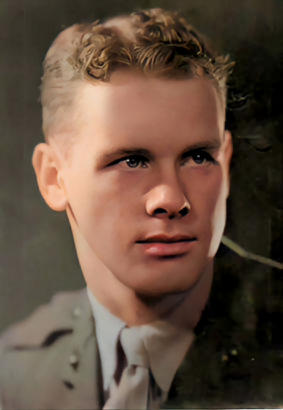
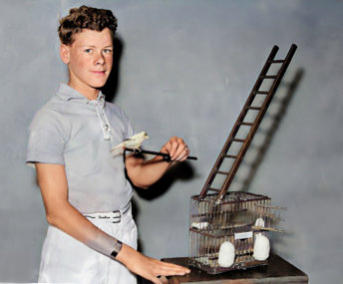
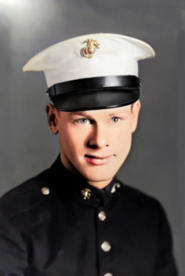
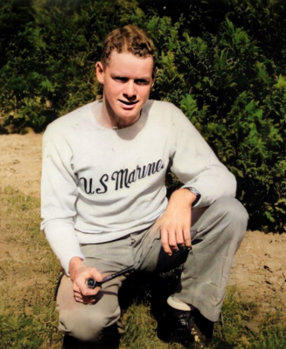
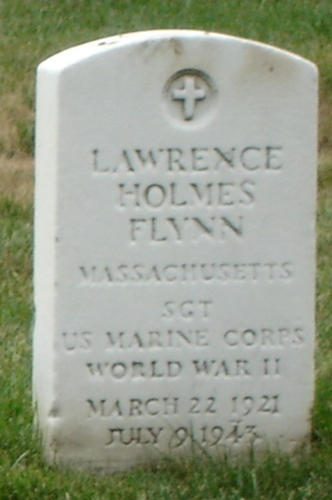


- World War I - Menu
- WWI Stories and Articles
- Photos - Yarmouth Soldiers
- Selection of World War I Songs
- WWI Casualties of Yarmouth, NS
- Those Who Served - Yarmouth, NS
- WWI Casualties Digby Co. NS
- WWI Casualties Shelburne Co. NS
- Merchant Mariners (1915) Yarmouth, NS
- Canadian Forestry Corps - Non Yarmouth Birth/Residence Enlistments
- US Draft Registry - Yarmouth NS Born


- World War II - Menu
- WWII Stories and Articles
- Telegraphist Air Gunners
- WWII Casualties of Nova Scotia
- US Casualties with NS Connection
- Far East/Pacific Casualties with NS Connection
- Merchant Navy Casualties Nova Scotia
- Nova Scotia WWII Casualties Holten Canadian War Cemetery
- D-Day Casualties - Nova Scotia
- CANLOAN Program Casulaties - Nova Scotia
- Battle of the Bulge Casualties - Nova Scotia
- WWII Casualties Yarmouth NS
- Yarmouth Casualties - RCAF RAF Canadian Army WWII
- Yarmouth Co., Marrages WWII
- Casualties Non-Born/Residents with Connection to Yarmouth Co., Nova Scotia.
- WWII Casualties Digby Co., NS
- Non-Nova Scotian WWII Casualties Buried in Nova Scotia
- WWII RCAF Casualties Aged 16-18
- Brothers/Sisters Who Served - World War II













